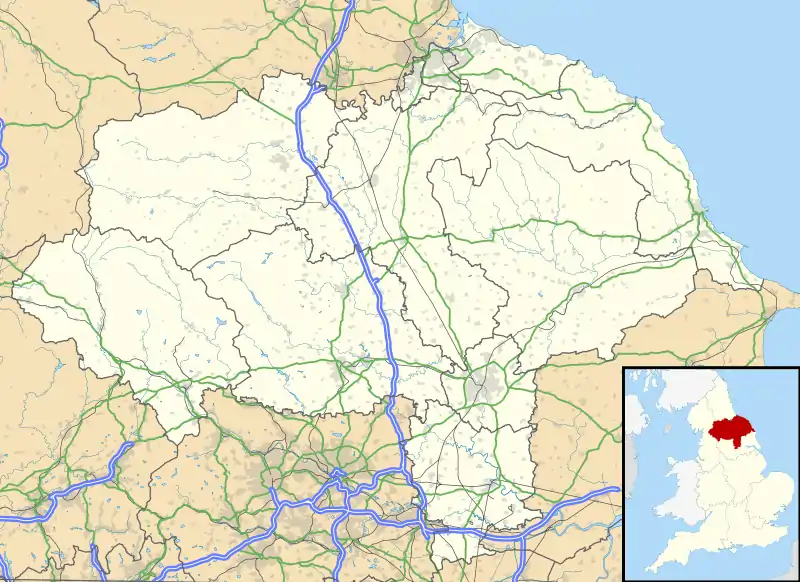RAF Topcliffe
Royal Air Force Topcliffe or RAF Topcliffe (ICAO: EGXZ) is a Royal Air Force station in North Yorkshire, England. It is home to No. 645 Volunteer Gliding Squadron flying the Grob Viking T.1 glider.
| RAF Topcliffe | |||||||||
|---|---|---|---|---|---|---|---|---|---|
| Part of RAF Linton-on-Ouse | |||||||||
| Near Topcliffe, North Yorkshire in England | |||||||||
 Grob Viking TX1, similar to that flown by 645 VGS at Topcliffe. | |||||||||
 RAF Topcliffe Shown within North Yorkshire | |||||||||
| Coordinates | 54°12′20″N 001°22′56″W | ||||||||
| Type | Relief Landing Ground | ||||||||
| Area | 117 hectares | ||||||||
| Site information | |||||||||
| Owner | Ministry of Defence | ||||||||
| Operator | Royal Air Force | ||||||||
| Controlled by | No. 22 Group (Training) | ||||||||
| Site history | |||||||||
| Built | 1939/40 | ||||||||
| In use | 1940-Present | ||||||||
| Airfield information | |||||||||
| Identifiers | ICAO: EGXZ, WMO: 03265 | ||||||||
| Elevation | 28 metres (92 ft) AMSL | ||||||||
| |||||||||
| Source: RAF Topcliffe Defence Aerodrome Manual[1] | |||||||||
Since the British Army took over a large part of the site in 1974, the airfield is now a small enclave within what is now known as Alanbrooke Barracks.
History
Topcliffe opened in September 1940 as a bomber station in RAF Bomber Command and was home to No. 77 Squadron and No. 102 Squadron, both flying the Armstrong Whitworth Whitley heavy bomber.[2] There was a decoy site at Raskelf. No. 419 Squadron and No. 424 Squadron of the Royal Canadian Air Force (RCAF) moved in flying Vickers Wellington bombers and later, the Handley Page Halifax III.[2] On 1 January 1943 the station was transferred to No. 6 Group RCAF and became a training station. The station, along with sub-stations at Wombleton, Dalton and Dishforth were designated as No. 61 (Training) Base in late 1943.[3]
No.1 Air Navigation School was located at Topcliffe between March 1957 & December 1961. The Air Electronics school came in January 1962 and from 1967 became the Air Electronics & Engineers School, flying Vickers Varsity T.1 aircraft.
From October 1964 the Northern Communications Squadron flew Avro Anson C.19 aircraft, replacing them with Beagle Basset CC.1 in 1965. The squadron left Topcliffe in January 1969.
The Airman Aircrew Initial Training School was located at Topcliffe from January 1967 until February 1970.
No. 15 Aviation Flight AAC flew de Havilland Canada DHC-2 Beaver AL.1 aircraft from the early 1970s and No. 666 Aviation Squadron AAC flew Westland Scout AH.1 helicopters between 1973 and 1978.
In 1974 much of the station was transferred to the British Army and became Alanbrooke Barracks, now home of 4th Regiment Royal Artillery. However, all flying facilities remain intact. The wartime control tower, with modifications, is still used, and the station is referred to as RAF Topcliffe by the RAF.[3]
During the eighties, Topcliffe was home of the Royal Navy Elementary Flying School. In the nineties it was temporarily home to a Shorts Tucano squadron of the RAF Central Flying School. It was the home of the Tucano Air Navigation Squadron, teaching student navigators of both the Royal Air Force and the Royal Navy until April 2002 when it moved to RAF Linton-on-Ouse.[3]
During the 1990s and until 2001, the airfield was utilised by Merlin Parachute Club, home to both the 4 Para parachute display team and the University of York Sport Parachute Club.[3]
No. 635 Volunteer Gliding Squadron operated from Topcliffe from 2009 when it moved from its former home at RAF Samlesbury.[3] The unit disbanded in 2016 as part of the relaunch of air cadet aviation.[4]
Operations

RAF Topcliffe is a satellite station serving in the role of a Relief Landing Ground for Shorts Tucano T1 aircraft of No. 1 Flying Training School based nearby at RAF Linton-on-Ouse (one of two, the other being Dishforth Airfield). No RAF personnel are based permanently at the airfield and airfield services are provided by personnel assigned to RAF Linton-on-Ouse.
The last remaining RAF unit based at Topcliffe is No. 645 Volunteer Gliding Squadron, who teach Air Cadets to fly the Grob Viking T1.
As of March 2012, the station is the permanent base of one of the two Yorkshire Air Ambulances.[7]
Since the British Army took over a large part of the site in 1974, the airfield is now a small enclave within what is now known as Alanbrooke Barracks.
See also
References
Citations
- "RAF Topcliffe Defence Aerodrome Manual (DAM)" (PDF). RAF Linton-on-Ouse. Military Aviation Authority. 27 June 2014. Retrieved 27 August 2017.
- Jefford 1988, p. 00.
- "Airfield History". No. 645 Volunteer Gliding Society. Retrieved 30 March 2014.
- Brazier, Julian (10 March 2016). "Air Cadet Aviation Relaunch:Written statement - HCWS605". UK Parliament. Retrieved 19 November 2017.
- "Gliders Return to 645 VGS at RAF Topcliffe". Royal Air Force Air Cadets. 17 October 2016. Retrieved 19 November 2017.
- "Topcliffe Air Support Unit". Yorkshire Air Ambulance. Retrieved 19 November 2017.
- "HRH The Duke of York KG officially opens our Northern Airbase". Yorkshire Air Ambulance. Retrieved 20 July 2012.
Bibliography
- Jefford, C.G. RAF Squadrons, a Comprehensive Record of the Movement and Equipment of all RAF Squadrons and their Antecedents since 1912. Shrewsbury, Shropshire, UK: Airlife Publishing, 1988. ISBN 1-84037-141-2.
External links
| Wikimedia Commons has media related to RAF Topcliffe. |
